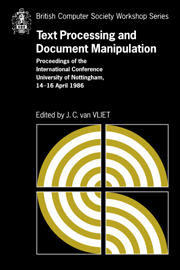 Text Processing and Document Manipulation
Text Processing and Document Manipulation Book contents
- Frontmatter
- Contents
- Preface
- The Design of Lucida®: an Integrated Family of Types for Electronic Literacy
- Tabular Typography
- A Simple Mechanism for Authorship of Dynamic Documents
- VORTEXT: VictORias TEXT reading and authoring system
- An Approach to the Design of a Page Description Language
- Intelligent Matching and Retrieval for Electronic Document Manipulation
- A Disciplined Text Environment
- Semantic Guided Editing: A Case Study On Genetic Manipulations
- Trends and Standards in Document Representation
- Textmaster – document filing and retrieval using ODA
- Combining Interactive Document Editing with Batch Document Formatting
- Formatting Structure Documents: Batch versus Interactive?
- Advanced Catalogue Production at Unipart
- Legibility of Digital Type-fonts and Comprehension in Reading
- An Overview of the W Document Preparation System
- Grif: An Interactive System for Structured Document Manipulation
- Procedural Page Description Languages
- A Strategy for Compressed Storage and Retrieval of Documents
- CONCEPT BROWSER: a System for Interactive Creation of Dynamic Documentation
- An Integrated, but not Exact-Representation, Editor/Formatter
- An Annotated Bibliography on Document Processing
- Systems used
Tabular Typography
Published online by Cambridge University Press: 05 May 2010
- Frontmatter
- Contents
- Preface
- The Design of Lucida®: an Integrated Family of Types for Electronic Literacy
- Tabular Typography
- A Simple Mechanism for Authorship of Dynamic Documents
- VORTEXT: VictORias TEXT reading and authoring system
- An Approach to the Design of a Page Description Language
- Intelligent Matching and Retrieval for Electronic Document Manipulation
- A Disciplined Text Environment
- Semantic Guided Editing: A Case Study On Genetic Manipulations
- Trends and Standards in Document Representation
- Textmaster – document filing and retrieval using ODA
- Combining Interactive Document Editing with Batch Document Formatting
- Formatting Structure Documents: Batch versus Interactive?
- Advanced Catalogue Production at Unipart
- Legibility of Digital Type-fonts and Comprehension in Reading
- An Overview of the W Document Preparation System
- Grif: An Interactive System for Structured Document Manipulation
- Procedural Page Description Languages
- A Strategy for Compressed Storage and Retrieval of Documents
- CONCEPT BROWSER: a System for Interactive Creation of Dynamic Documentation
- An Integrated, but not Exact-Representation, Editor/Formatter
- An Annotated Bibliography on Document Processing
- Systems used
Summary
ABSTRACT
This paper presents a comprehensive survey of the typographic issues for laying out information within two-dimensional tables. Early typesetting systems formatted tables by coding the table style and layout into the program, and later systems provided a limited range of typographic features. The typographic issues include table structure, alignment of rows and columns simultaneously, formatting styles, treatment of whitespace within a table, graphical embellishments, placement of footnotes, various readability issues, and the problems of breaking large tables. Extending the table formatting problem to both page layout and arrangement of mathematical notation is highlighted, as is the need for interactive design tools for table layout.
Introduction
This paper presents a comprehensive survey of the typographic issues for laying out information within a two-dimensional table. Tables are a concentrated form of the more general layout problem; one can find table formatting analogies in both the larger-scale problem of page makeup, and the smaller-scale problem of aligning notation within a mathematical equation.
Few table formatting tools have addressed all the issues raised by this paper. In fact, it was a challenge to identify the various issues that typographers, compositors, and graphic designers have managed with great skill through the traditional graphic arts processes. Thus this paper provides a checklist for the designs and implementations of new table formatting tools, algorithms, and structures.
- Type
- Chapter
- Information
- Text Processing and Document ManipulationProceedings of the International Conference, University of Nottingham, 14-16 April 1986, pp. 18 - 33Publisher: Cambridge University PressPrint publication year: 1986
- 3
- Cited by


